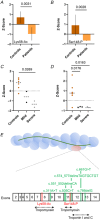Pathogenic TNNT1 variants are associated with aberrant thin filament compliance and myofibre hyper-contractility
- PMID: 40320982
- PMCID: PMC12206437
- DOI: 10.1113/JP288109
Pathogenic TNNT1 variants are associated with aberrant thin filament compliance and myofibre hyper-contractility
Abstract
In skeletal muscle, troponin T (TnT) exists in two isoforms, slow skeletal TnT (ssTnT) and fast skeletal TnT (fsTnT), encoded by the TNNT1 and TNNT3 genes, respectively. Nonsense or missense TNNT1 variants have been associated with skeletal muscle weakness and contractures and a histopathological appearance of nemaline myopathy (NM) on muscle biopsy. Little is known about how TNNT1 mutations ultimately lead to muscle dysfunction, preventing the development of targeted therapeutic interventions. Here, we aimed to identify the underlying molecular biophysical mechanisms, by investigating isolated skeletal myofibres from patients with TNNT1-related NM as well as from controls through a combination of structural and functional assays. Our studies revealed variable and unusual ssTnT and fsTnT expression patterns and post-translational modifications. We also observed that, in the presence of TNNT1 variants, the thin filament was more compliant, and this was associated with a higher myofibre Ca2+ sensitivity. Altogether, our findings suggest TnT remodelling as the key mechanism ultimately leading to molecular and cellular hyper-contractility, and then inhibitors of altered contractility as potential therapeutic modalities for TNNT1-associated NM. KEY POINTS: No therapeutic treatment exists for patients with genetic TNNT1 mutations and skeletal muscle weakness/contractures. In these patients, expression and post-translational modifications of troponin T are severely disrupted. These are associated with changes in thin filament compliance where troponin T is located. All these induce muscle fibre hyper-contractility that can be reversed by mavacamten, a myosin ATPase inhibitor.
Keywords: congenital myopathy; contracture; force; skeletal muscle; troponin.
© 2025 The Author(s). The Journal of Physiology published by John Wiley & Sons Ltd on behalf of The Physiological Society.
Conflict of interest statement
C.T.A.L. is an employee of Novo Nordisk A/S. This position began after their work on this paper and the position had no influence on the results or conclusions drawn. M.W.L. is the CEO and founder of Diverge Translational Science Laboratory, which works with numerous companies in the areas of therapeutic development and testing. His work at Diverge is unrelated to the therapeutic options discussed here and his position had no influence on the results or conclusions drawn. A.L.H. is an owner of Accelerated Muscle Biotechnologies Consultants LLC, which performed the X‐ray data reduction and analysis, but services rendered were not linked to outcome or interpretation.
Figures









Similar articles
-
A homozygous single-nucleotide variant in TNNT1 causes abnormal troponin T isoform expression in a patient with severe nemaline myopathy: A case report.J Neuromuscul Dis. 2025 Sep;12(5):689-698. doi: 10.1177/22143602251339569. Epub 2025 May 21. J Neuromuscul Dis. 2025. PMID: 40397026
-
The loss of slow skeletal muscle isoform of troponin T in spindle intrafusal fibres explains the pathophysiology of Amish nemaline myopathy.J Physiol. 2019 Aug;597(15):3999-4012. doi: 10.1113/JP278119. Epub 2019 Jul 3. J Physiol. 2019. PMID: 31148174 Free PMC article.
-
Functional Basis of Three New Recessive Mutations of Slow Skeletal Muscle Troponin T Found in Non-Amish TNNT1 Nemaline Myopathies.Biochemistry. 2016 Aug 16;55(32):4560-7. doi: 10.1021/acs.biochem.6b00577. Epub 2016 Aug 2. Biochemistry. 2016. PMID: 27429059
-
A systematic review of adult-onset clinically amyopathic dermatomyositis (dermatomyositis siné myositis): a missing link within the spectrum of the idiopathic inflammatory myopathies.J Am Acad Dermatol. 2006 Apr;54(4):597-613. doi: 10.1016/j.jaad.2005.10.041. Epub 2006 Jan 23. J Am Acad Dermatol. 2006. PMID: 16546580
-
Antidepressants for pain management in adults with chronic pain: a network meta-analysis.Health Technol Assess. 2024 Oct;28(62):1-155. doi: 10.3310/MKRT2948. Health Technol Assess. 2024. PMID: 39367772 Free PMC article.
References
-
- Abdulhaq, U. N. , Daana, M. , Dor, T. , Fellig, Y. , Eylon, S. , Schuelke, M. , Shaag, A. , Elpeleg, O. , & Edvardson, S. (2016). Nemaline body myopathy caused by a novel mutation in troponin T1 (TNNT1). Muscle, & Nerve, 53(4), 564–569. - PubMed
-
- Berg, S. , Kutra, D. , Kroeger, T. , Straehle, C. N. , Kausler, B. X. , Haubold, C. , Schiegg, M. , Ales, J. , Beier, T. , Rudy, M. , Eren, K. , Cervantes, J. I. , Xu, B. , Beuttenmueller, F. , Wolny, A. , Zhang, C. , Koethe, U. , Hamprecht, F. A. , & Kreshuk, A. (2019). ilastik: Interactive machine learning for (bio)image analysis. Nature Methods, 16(12), 1226–1232. - PubMed
MeSH terms
Substances
Grants and funding
LinkOut - more resources
Full Text Sources
Miscellaneous
